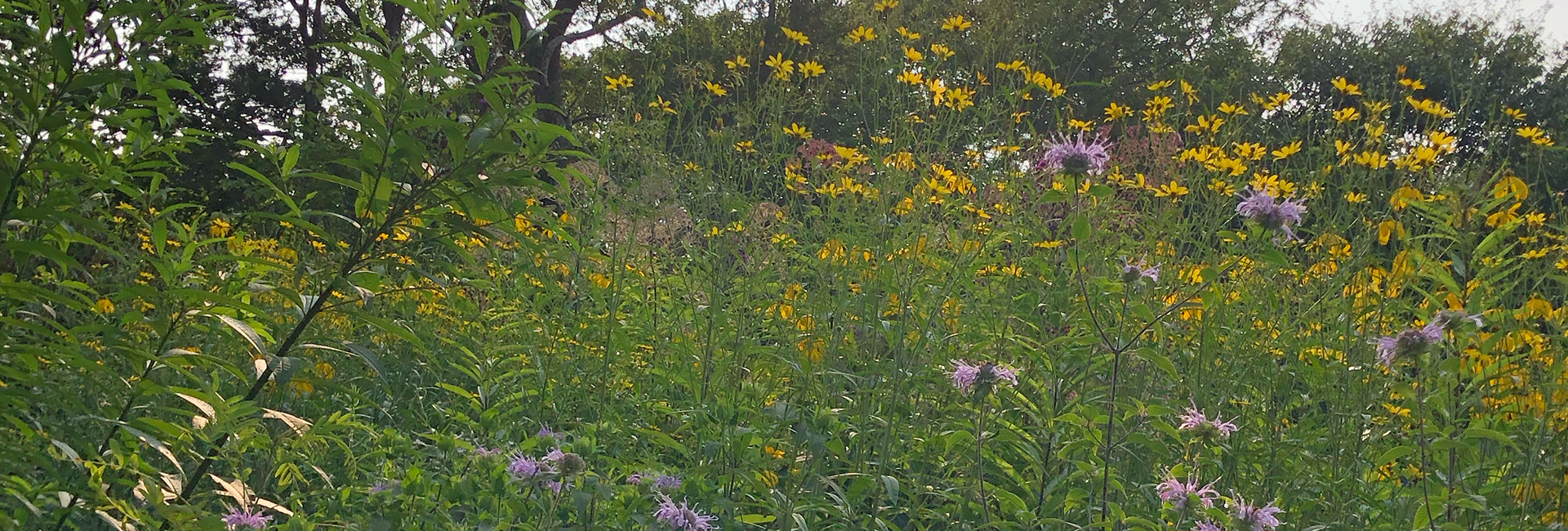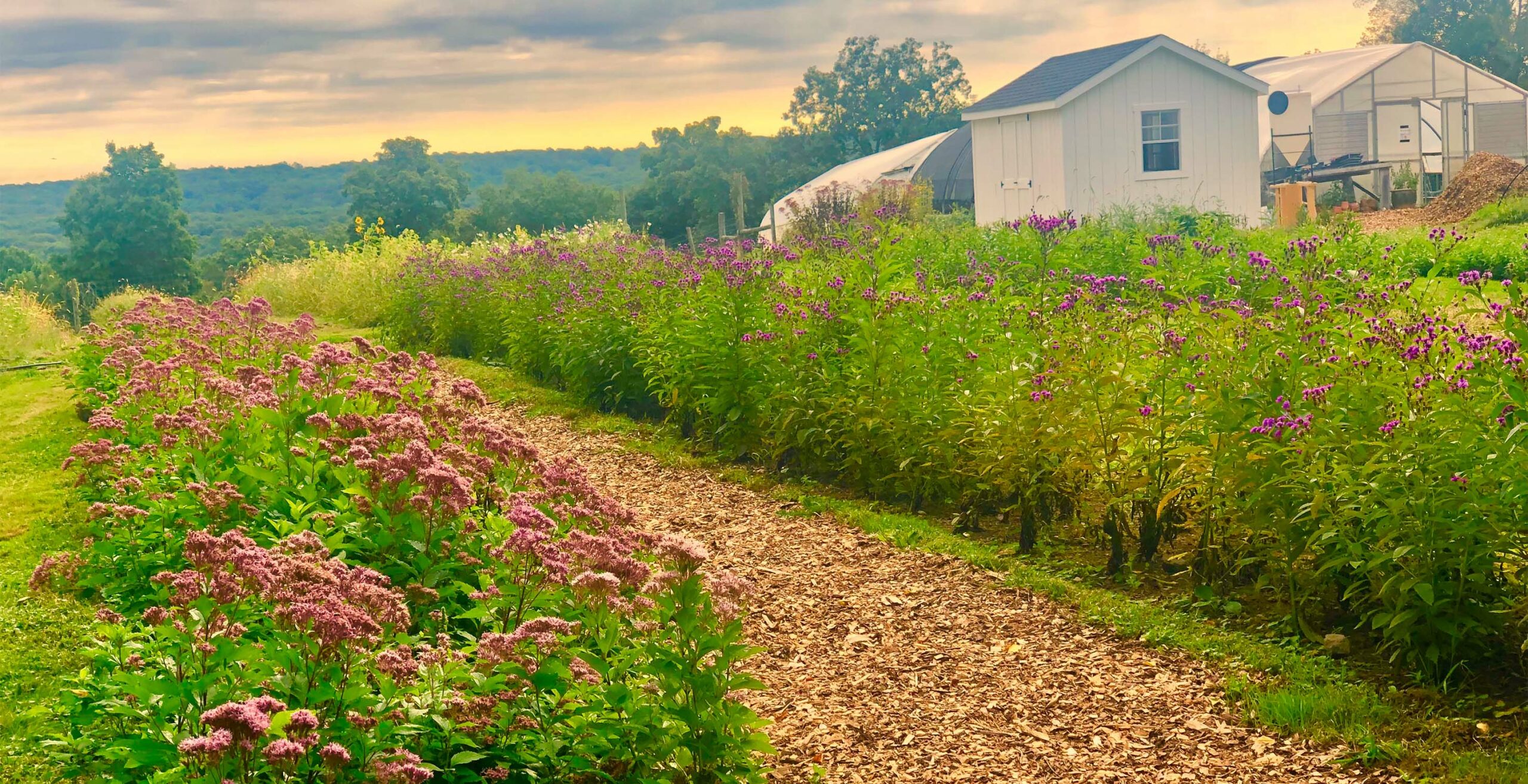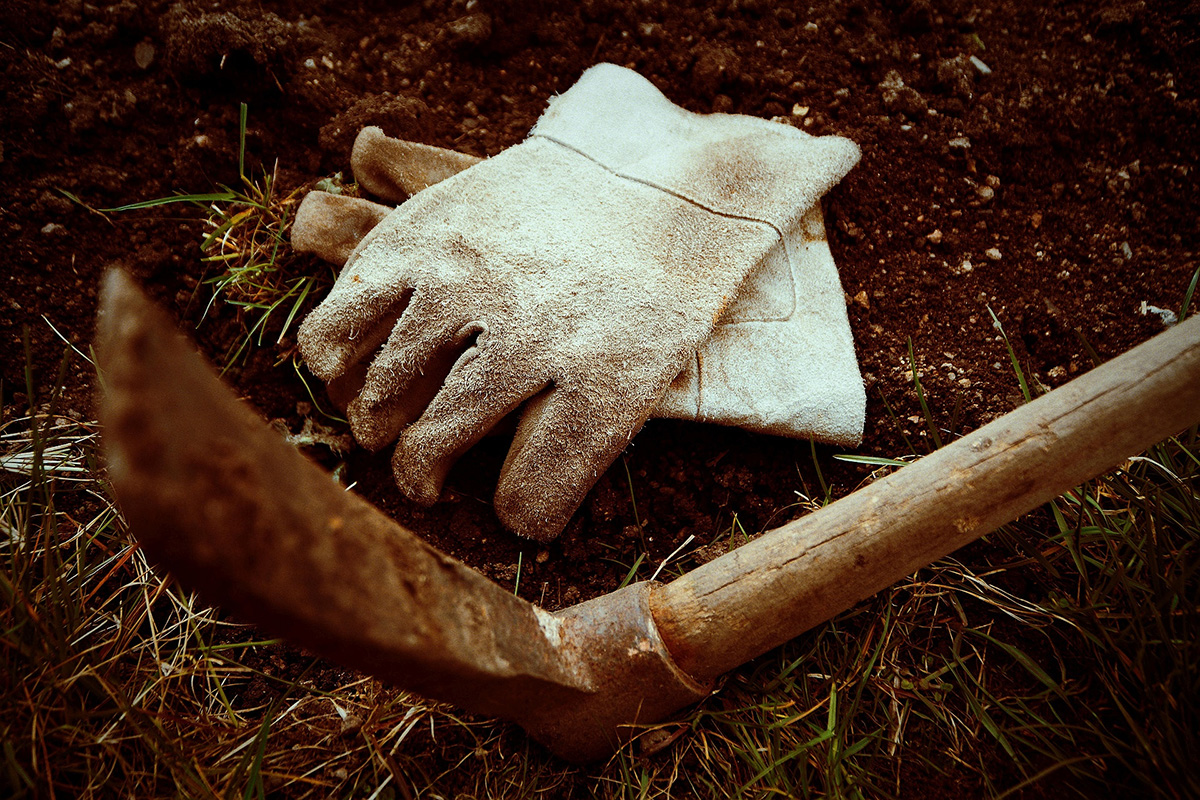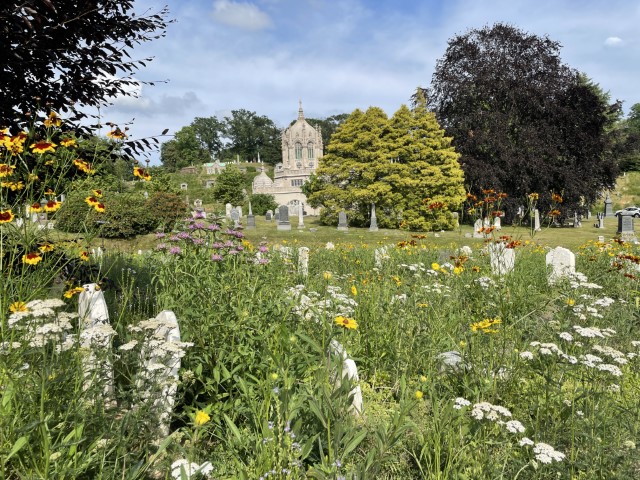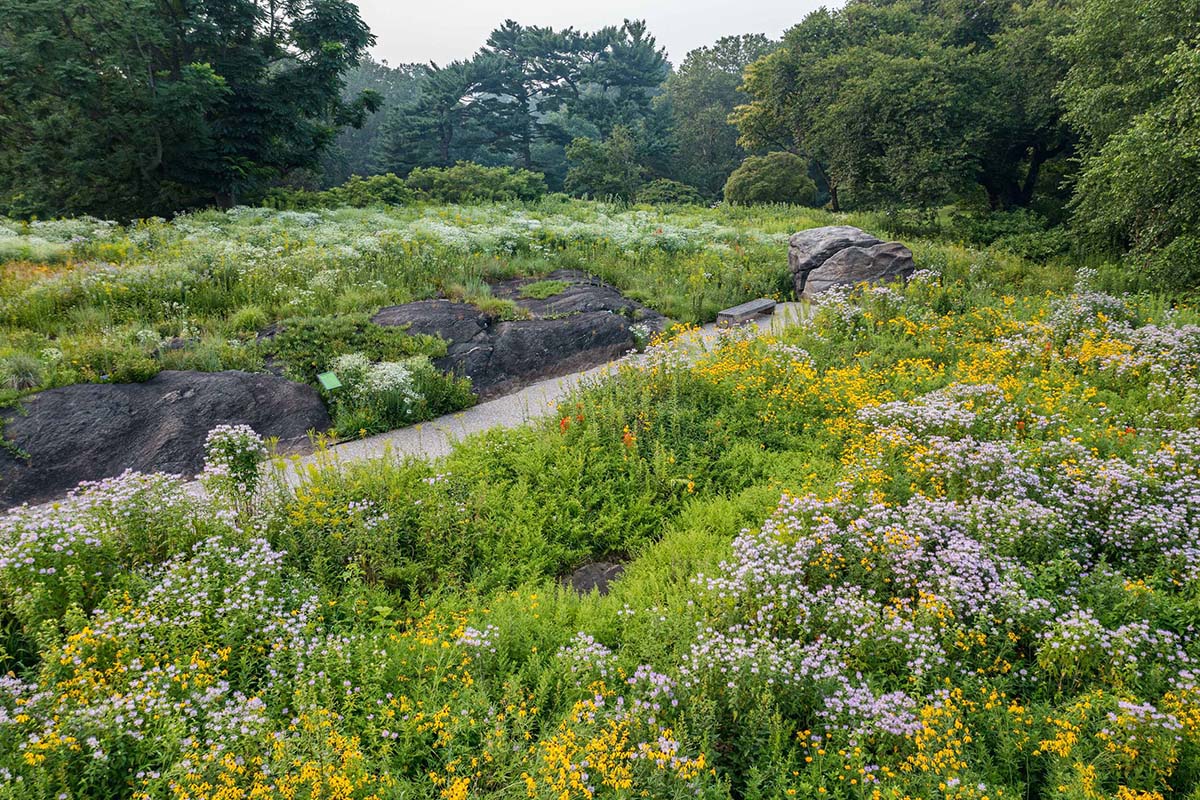
Perfect Earth Project presented our second annual sold-out symposium at Stone Barns Center for Food & Agriculture on May 7, 2025, gathering experts to address the management of invasive plants. Those introduced plants that cause ecological harm are a major driver of the biodiversity crisis the world is now facing: 25 percent of species are threatened by extinction, and ecosystems have declined by 47 percent relative to historical area, notes Evelyn Beaury, Assistant Curator at the New York Botanical Garden (NYBG). (Read our story about her research here.)
Many gardeners are familiar with the daunting feeling when encountering a woodland full of harmful barberry or a field of mugwort. The experts convened for the symposium are finding ways to reduce the impact, trying various non-chemical methods. “The easiest way to reduce invasive species is to plant with native plants,” Beaury says. (To learn about native alternatives to invasive plants, read our story here.) But first we need to create space for them to grow and flourish.
Before we share their tips on how to manage invasive plants, a note about the power of language: All the talk about invasive plants can go to a dark place very quickly— especially today when it feels like we are faced with a barrage of racist and xenophobic language. Ecologist and lead horticulturist at the American Horticultural Society Rebecca McMackin wants us to change the way we talk about them. Using terms like “war on invasives,” describing plants as “evil,” and relying on country descriptors to name plants can be polarizing. The plants aren’t evil. They didn’t invade us. They’re here because we, humans, brought them here. Instead of saying Oriental bittersweet, for instance, opt for “round-leaf bittersweet,” which as McMackin notes is “super helpful because it helps to differentiate between the invasive and native bittersweet.” Or rather than calling it Japanese knotweed, identify it as Itadori knotweed, she says, which is a common name in Japan. Let’s choose our words carefully. I know I’m trying to. “Positive rhetoric is much more effective and make us happier,” says McMackin. “Focus on the positive—through beauty, wonder, and possibility.”
7 Ways to Manage Invasive Plants
Here are some of the chemical-free methods our experts have used. Some anyone can do, others require special skills and equipment. Whatever option you try, know there is no one-size-fits-all approach, but that all these methods are better than herbicides, which kill indiscriminately, can persist in the ecosystem, and can be harmful to our health. And as all of the speakers stressed, it’s important to be vigilant, keep up with maintenance, and act quickly when you see an unwanted plant.
Smothering
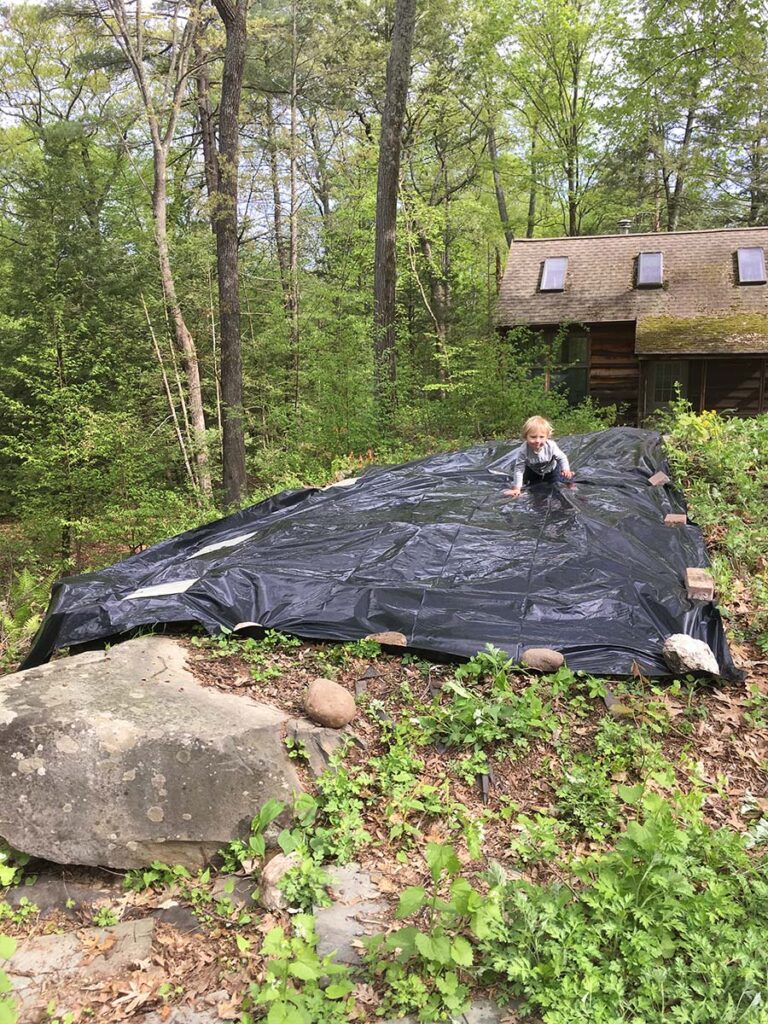
This is the day the 5 ml thick black plastic tarp was installed in May of 2018 atop a mature stand of mugwort. She admits the tarp is a bit of an eyesore. Inspired by artists like Christo and Jeanne-Claude and Yayoi Kusama, Gamell hopes artists will team up with horticulturists to create beautiful tarps, preferably not made from plastic. Photograph by Ashley Gamell.
With a small child and another on the way, Ashley Gamell, owner of Studio Hopeland Landscape Design, knew she didn’t want to use any chemicals (or hire anyone to use them) to get rid of the mature stands of mugwort that she had inherited at her new house. She opted to smother them using a 5 mm thick sheet of black plastic. After keeping the area covered for two full growing seasons, she removed the plastic, added some native plugs and shrubs, and then “allowed nature to repopulate the areas with native wild plants.”
Soon hepaticas started blooming. Eastern columbine popped up. And white snakeroot flowered. The method is easy to do and inexpensive, but looking at sheets of black plastic is, as Gamell admits, not the most beautiful—though the results were! Her dream is for artists to team up with gardeners to create better looking tarps, preferably not plastic. Artists—this is your call to action!
Ashley Gamell Image 7029 – After Gamell removed the tarp, this area now features sensitive fern from wild transplants from the site, and many other grasses and wildflowers established from plugs and natural recruitment. Sweetfern and bayberry shrubs grow on the hillside and some non-native Japanese anemone ‘Honorine Jobert’ and autumn moor grass (Sesleria autumnalis) have been added as ornamentals. Photograph by Ashley Gamell.
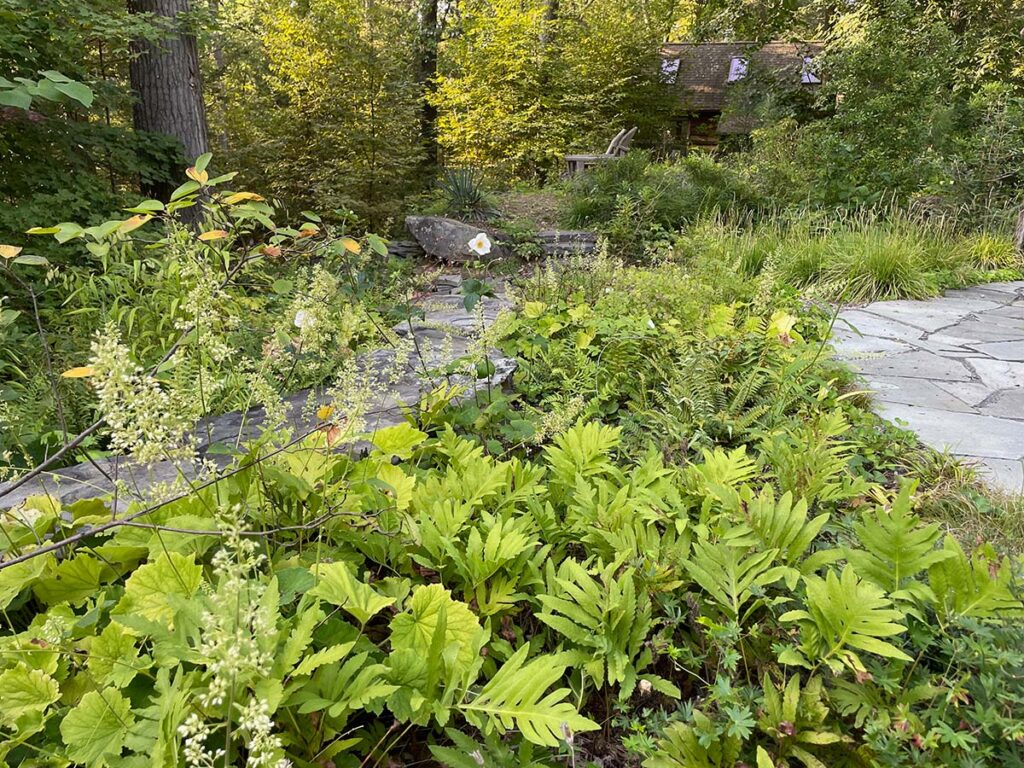
Solarization
Steep slopes at Governors Island made it extremely difficult to use machines or sheep to control the spread of mugwort. (Read a conversation with Governors Island’s Andi Pettis here.) So Sarma Ozols, horticultural supervisor at the Trust for Governors Island, tried solarization, which essentially cooks the plants beneath clear plastic. To prep the area, first she and her team had to clear it. They carefully operated a remote mower and used brush cutters to remove any plant material that might poke up through the clear plastic. Then they dug trenches, placed wrapped metal poles in the trenches to hold down the plastic, irrigated the area to moisten the soil, and covered it with thick, clear plastic. (Ozols says they used 6 mm plastic because of the strong winds, but that 4 mm sheets might conduct heat better. It depends on your site.) “It’s very important to keep the air out,” she explains.
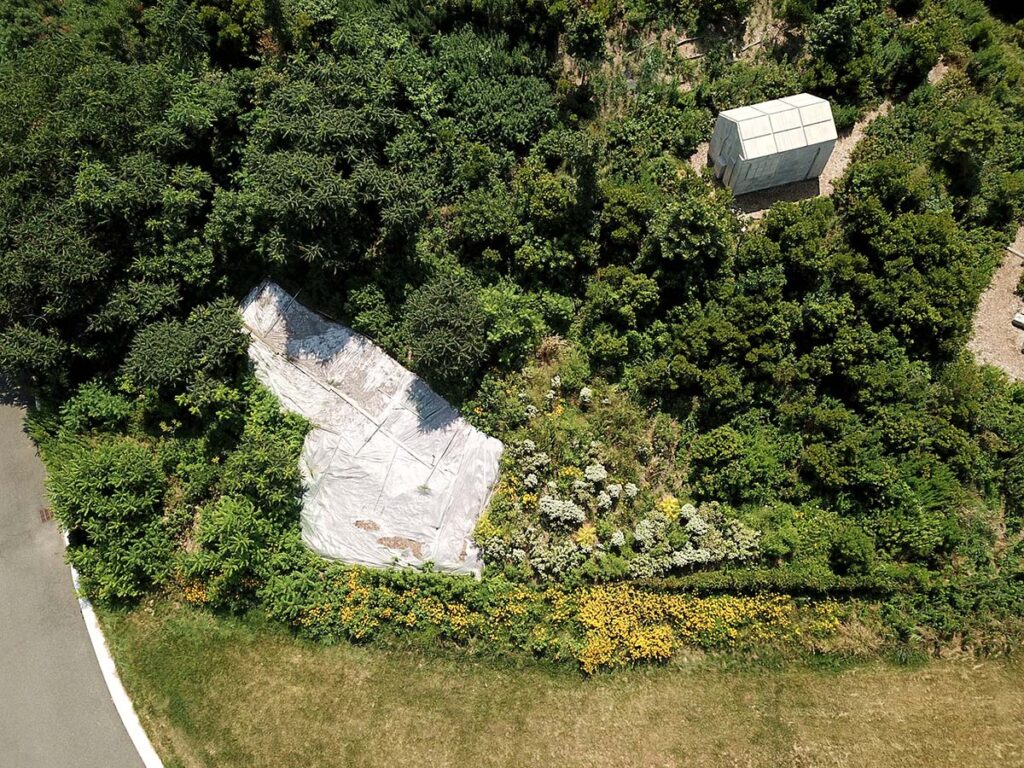
The solarization patch on Governors Island. Photograph by Logan Fisher/The Trust for Governors Island.
She recommends starting the process in May and taking off the plastic by September or October. Once she removed the plastic, she got rid of all the “fried rhizomes,” and with her team planted densely with native plugs and seeds, prioritizing ground covers like Carex brevior, Virginia strawberry (Fragaria virginiana), golden ragwort (Packera aurea). “Plants are much more effective than mulch for keeping the weeds out,” she says. Solarization is effective, but you may still see sprouts of mugwort pop up. When you do, act quickly. “Early intervention is key,” says Ozols.
The following year after solarization, the hill is abloom with native flowers. Photograph by Logan Fisher/The Trust for Governors Island.
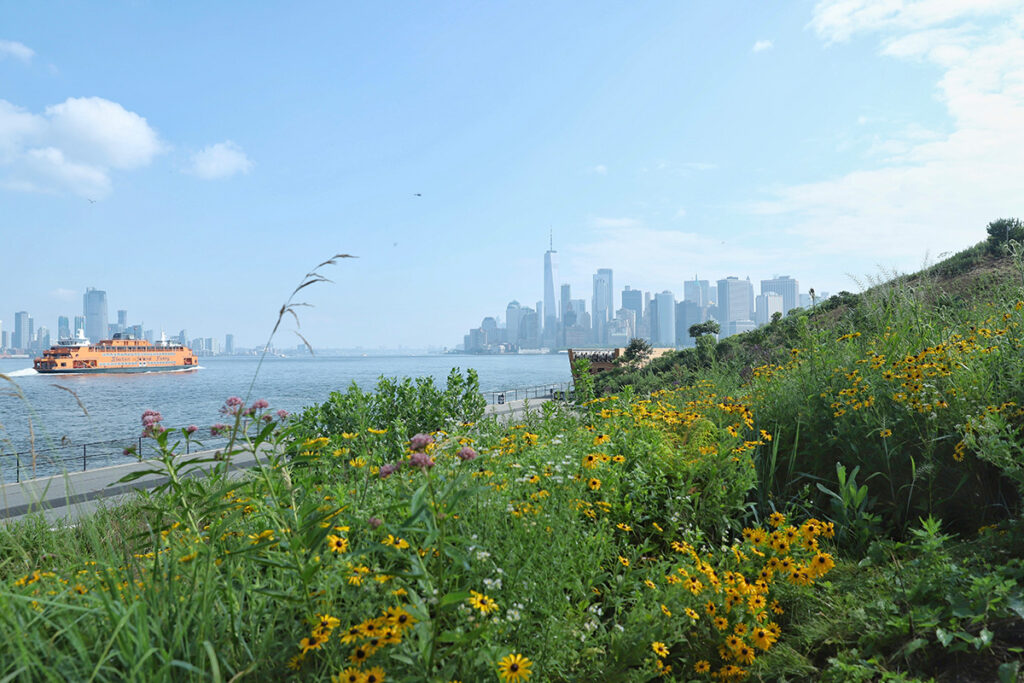
Timed Cutting
Faced with what Claire Davis, owner of Starflower Gardens, called an “intimidating tangle of mugwort and black swallow-wort,” she and Mia Wendel-DiLallo, owner of Seedhead Gardens, decided to practice timed cutting in a small herbaceous meadow near a stream and vernal pool. Manual timed cutting works best in small areas and allows you to be precise and target specific plants. In this case, it helped preserve some of the desirable and hard-to-find native species found in the meadow, like large swaths of low bush blueberry.
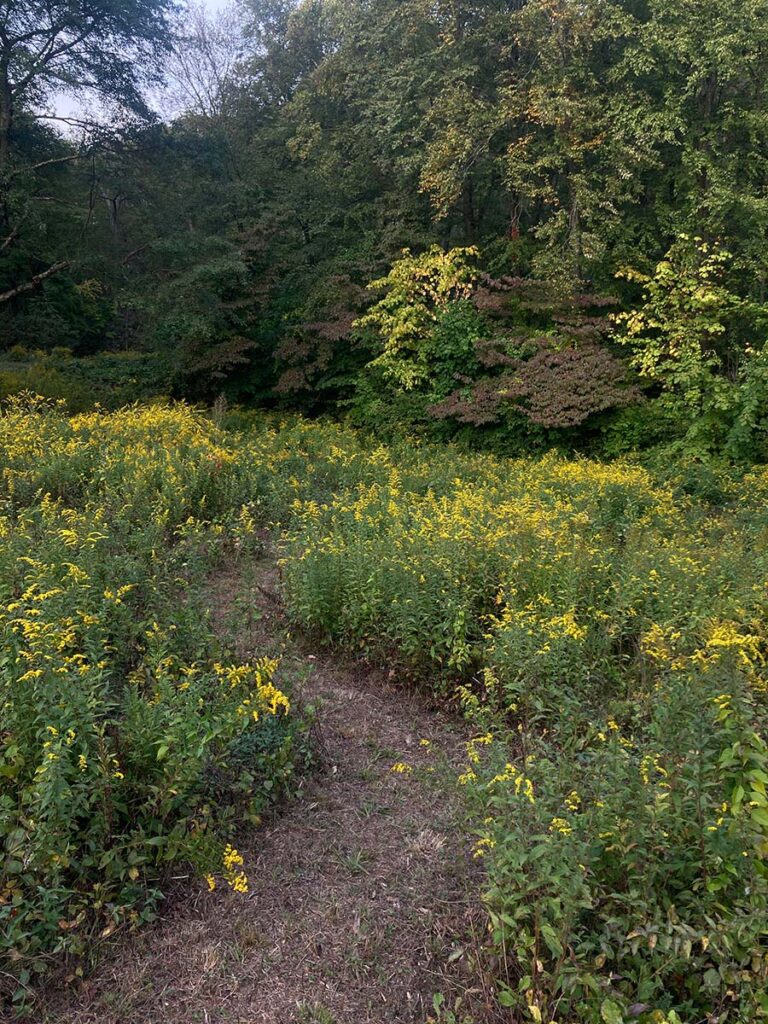
At the end of the season, with some areas cut back further than others, yellow wrinkle leaf goldenrod blooms and the fall foliage of flowering dogwood provides a contrasting background. Photography by Mia Wendel-DiLallo
When cutting back, timing is key. Since mugwort is a cold season plant, Davis recommends starting the first cutbacks when you begin mowing the lawn or when you sow cool-season crops, like radishes and spinach. “The first few early season cutbacks are pretty important since they limit the most rapid period of growth and remove the early-season advantage mugwort has over many other meadow plants,” she says. “There are often other aggressive plants (like native goldenrod) hiding in mugwort stands, even though it doesn’t look like it at first glance! Those plants will start to shade out the mugwort when the cutbacks are selective and consistent. The combination of reducing its vigor, plus the shade and root competition from native shrubs and tall, herbaceous plants, limits the presence of mugwort over time.”
Using a battery-powered steel string trimmer with a blade attachment and Okatsune hedge shears, Davis cut the mugwort back twice a month to a height of 1.5 feet to protect plants like those in the Aster family so they can still flower and set seed. Those remaining stems also offer protection with heavy rains and deer browse. They also planted with native plugs at the same time “to speed the process and bring more flowering plants into the sight lines,” says Wendel-DiLallo.
To preserve the orange butterfly weed that emerged in early July, Mia Wendel-DiLallo and Claire Davis used hedge shears to cut back the mugwort and black swallow-wort that grew around it. Photograph by Claire Davis
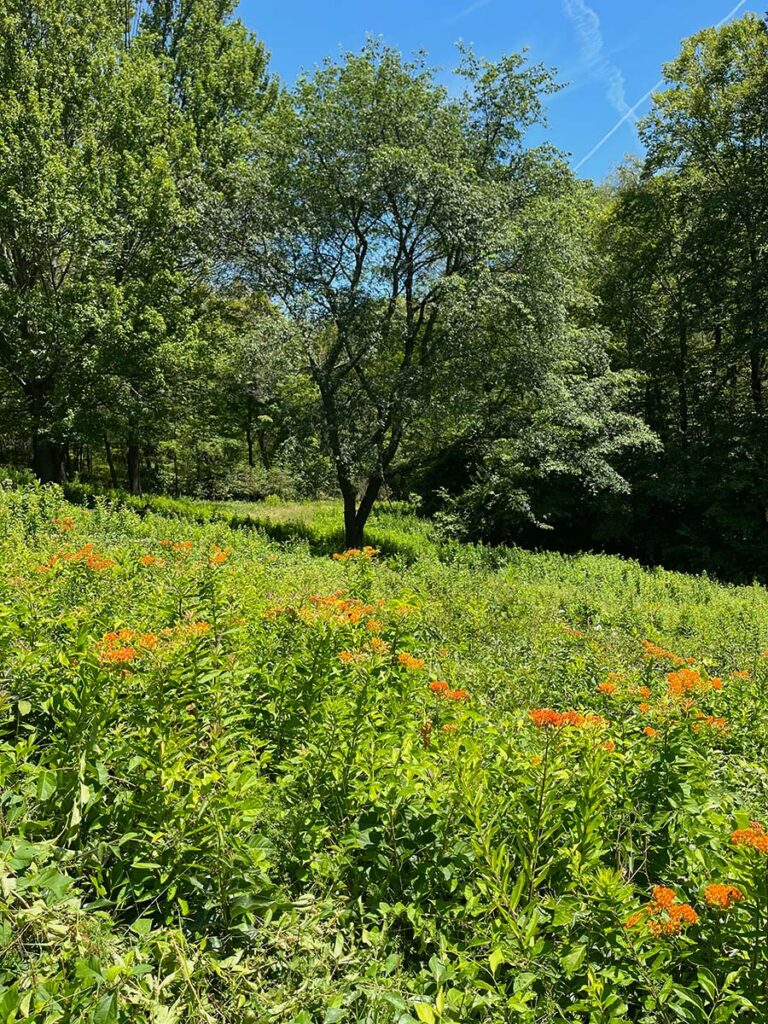
Torching
Digging out invasive shrubs like thorny multiflora rose and barberry is challenging—and potentially painful! Budd Ververka, the director of land management at Mianus River Gorge, found that using weed torches was very effective on multi-stemmed shrubs like multiflora rose, border privet, wineberry, and barberry and herbaceous stiltgrass and garlic mustard. To avoid any chance of starting a fire, Ververka recommends only using the torches during rainy days in the spring to target herbaceous plants like garlic mustard or stilt grass. For woody plants, he suggests torching the root crowns in winter when there is still snow on the ground to prevent the chance of the fire getting away.
Steaming
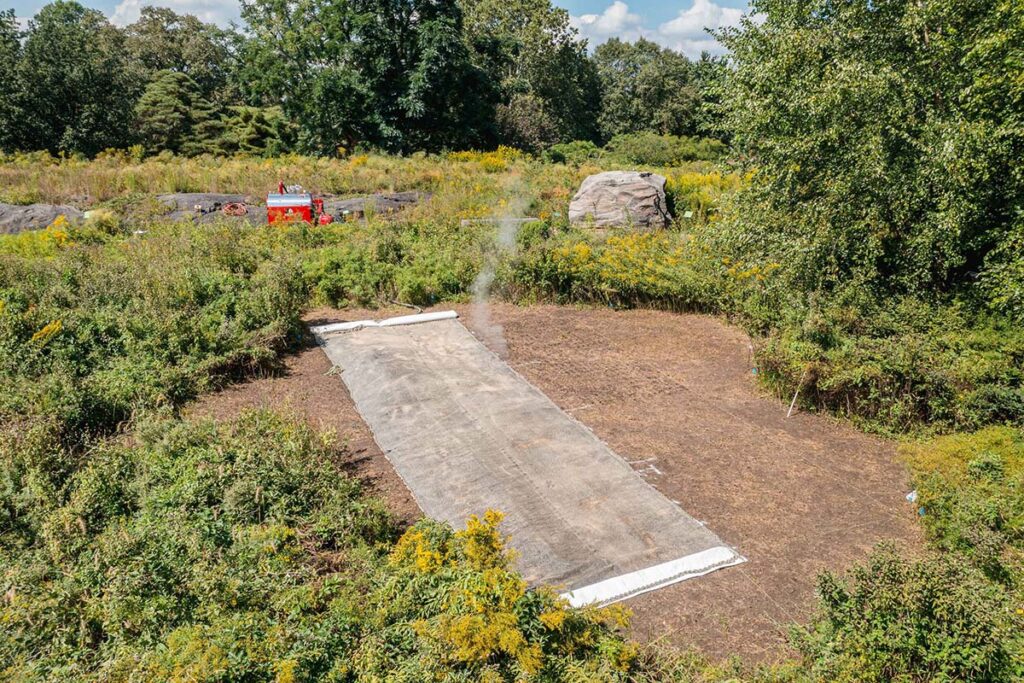
First steam treatment in progress in NYBG’s meadow in September of 2021Photograph courtesy of the New York Botanical Garden
Invasive plants are indiscriminate. They will go anywhere and everywhere—even to the world class New York Botanical Garden. The beautiful Native Plant Garden opened in 2013, but by 2021 the meadow had succumbed to mugwort pressures. Since the garden can see a million visitors, Michael Hagen, curator of the Rock Garden and Native Plant Garden, and his team needed quick results. They decided to try to steam away the mugwort in the fall.
After clearing the area (they discovered manually removing the weeds and then broadforking was the most effective), they placed a large steam blanket on the ground, covering it with a heavy chain to keep as much of the steam in as possible, and steamed for about two hours. They then seeded with a native Virginia wild rye cover crop to prevent any seeds setting in over the winter. In the spring, they replanted with native perennial plugs like Monarda fistulosa, Heliopsis, and a mix of native asters. They also discovered that adding biochar was “the magic ingredient” for improving plant health after steaming. Steaming is a very expensive process, but if you don’t want to use harmful herbicides, it’s the best way to clear an area quickly so you can manage it effectively, he says. “It’s an ongoing process, but one that is exciting,” says Hagen.
Forestry Mulching
What to do when a large woodland is covered in invasive woody plants? Penn Marchael, CEO of landscape design firm Pennington Grey, who has tried many different methods from brush cutting to pigs, recommends forestry mulching. It requires a machine (or attachment) that features a rotating cylinder with steel teeth that can clear the land of unwanted plants, shrubs, and trees, shredding the biomass and leaving it on the ground to enrich the soil and also provide some weed suppression.
Using a rotating cylinder with steel teeth, a forestry mulcher easily removes woody invasive plants. Photograph by Pennington Grey
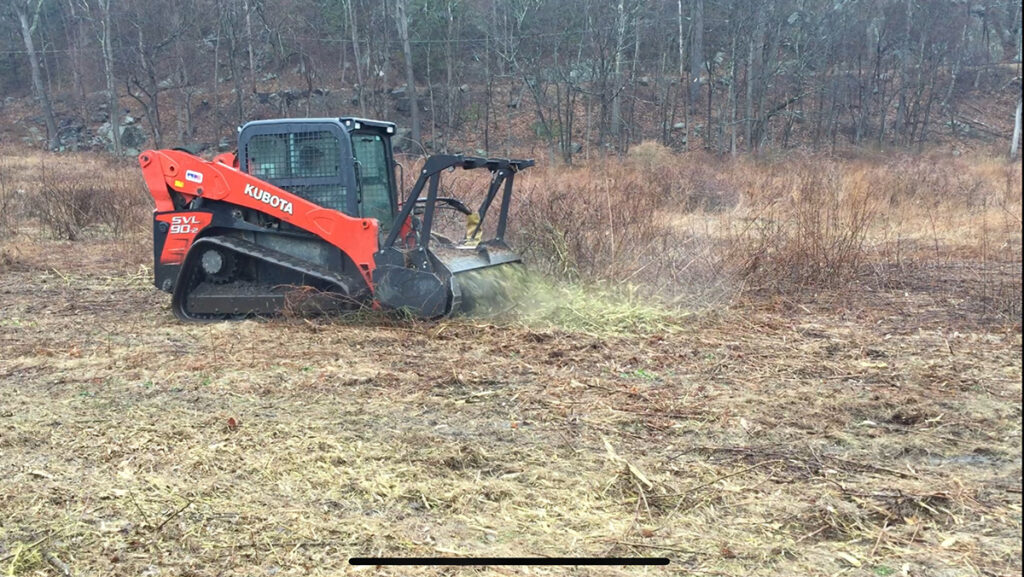
Forestry mulchers are quick, cost effective, have low ground pressure and compaction, and don’t create landfill waste. In a recent project, Anabel Roberts-McMichael, owner of Tend and Gather, who also employs forestry mulching, made sure to flag all of the native species at eye level that she wanted to preserve so the forestry mulcher would avoid them.
Roberts-McMichael recommends learning about the individual species you are trying to get rid of so you can plan your forestry mulching at the right time. Buckthorn, for example, stores their carbohydrates above ground, so if you remove them in the winter or fall, most of them won’t re-sprout. After the forest has been cleared of unwanted plants, Roberts-McMichael makes sure to help the overstory. She thins out weak trees to allow the stronger native ones to set seed and regenerate the forest. But there’s another hiccup. “You all know what happens when you plant native plants?” asks Roberts-McMichael. “Deer.” Deer have evolved with native plants for thousands of years and those plants provide medicine and fuel that the animals need. To protect the native plants that regenerate after the invasive ones have been cleared, Roberts-McMichael recommends enclosing areas with deer fencing.
Holistic Approach
Stone Barns Center for Food and Agriculture practices an integrated and diverse approach to invasive plant management. They use livestock for grazing and browsing. They carefully remove plants both manually and mechanically. They smother and solarize. And the chefs at Blue Hill harvest some for food. They have fried the sprouts of angelica tree Aralia elata, called taranome in Japan, tempura-style, and preserved young shoots of Itadori knotweed and made cups out of the mature stalks. (As Elijah Goodwin, director of ecological monitoring at Blue Hill, says, “The fastest way to see a natural resource to disappear is to get a human interest in it.”)
Goodwin encourages all practitioners to “think holistically, strategically, and long-term; use multiple management modalities; seek balance over eradication; and be patient and persistent.” Learn to listen to invasive plants. They “are a messenger, not an invader,” Goodwin says. “What are they telling us about things like deer over browse, soil degradation and impaction, and excessive disturbance?” If we begin to listen to them, we’ll learn better how to help restore the ecosystem.
Of course, the best thing you can is avoid growing invasives in the first place. As discussed in an earlier story with Beaury, invasive plants are still being sold today in nurseries—both in brick-and-mortar shops and online. Help reduce the spread by not buying these plants. “Let’s stop the damage before it happens rather than only focusing on repair,” says McMackin, who encourages us all to advocate for systemic change: Join your local garden club, talk to your neighbors, and act collectively to change laws and regulations to prevent these plants from being sold. Beaury also recommends signing up for the Regional Invasive Species and Climate Change (RISCC) network to stay abreast of the latest research and science.
by Melissa Ozawa
This story is just a brief recap of the symposium. Perfect Earth Project is offering a video of the entire symposium for a small fee. Order access here.
This is part of a series with Gardenista, which ran on May 16, 2025.
